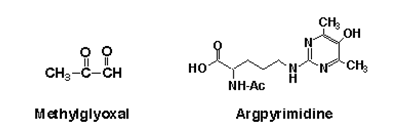 |
Oxidative Stress
Rev.081024 |
Anti-methylglyoxal antibody
(Anti MG monoclonal antibody, specific for argpyrimidine, clone #3C) |
|
| About methylglyoxal (MG) |
|
Methylglyoxal (MG), an endogenous metabolite
that increases in diabetes and is a common intermediate in the Maillard reaction (glycation), reacts with proteins and forms advanced glycation
end products (AGE). MG reacts with arginine residue in protein and forms numerous numbers of adducts, such as argpyrimidine.
This antibody is specific for argpyrimidine: N-(5-hydroxy-4,6-dimethylpyrimidine-2-yl)-L-ornithine.
|
 |
|
| Specifications |
| Clone #: |
3C |
| Antigen: |
MG-modified keyhole-lympet hemocyanine |
| Specificity: |
Specific for MG-modified protein (especially Argpyrimidine) |
| Subclass: |
Mouse IgG2a(kappa) |
| Form: |
Frozen (10mM PBS containing 0.1% NaN3 and 0.5% BSA, 100 µg/mL IgG.
Protein A purified. |
| Application: |
Immunohistochemistryˇ¨It is recommended that the antibody be tried at 0.5-1.0 µg/mL on
paraformaldehyde fixed tissue. |
| |
|
|
| Product name |
Code |
Content |
| Anti Methylglyoxal (MG) monoclonal antibody |
MMG-030n |
30 µg IgG |
|
Manufactured by NOF corporation, Japan. |
| FOR RESEARCH USE ONLY. Not for diagnostic, medical or other use. |
| Procedure |
| 1) |
Paraffin sections were deparaffinized and rehydrated. |
| 2) |
Sections were quenched for several minutes with 3% hydrogen peroxide,
rinsed in PBS, pretreated for 30 min with 3% nonimmune animal serum in PBS. |
| 3) |
Sections were incubated overnight at 4°C with a antibody at a
dilution of 1 µg/mL. |
| 4) |
Antibody binding was visualized by the avidin-biotin-immuno
peroxidase complex method using the Vectastain ABC kit (Vector, Burlingame, CA) according to the manufacturer's instructions. |
| 5) |
3,3-Diaminobenzidine tetrahydrochloride was used as the chromogen. |
| 6) |
Hematoxylin or Eosin was used as the counter stain. |
|
| Technical Note |
| 1) |
Sections from which the primary antibodies were omitted served as
negative reaction controls. |
| 2) |
For frozen materials, samples were fixed in 10% formalin,
immersed in 30% sucrose in PBS, embedded at OCT (Sakura, Tokyo, Japan), and stored at 80°C. |
| 3) |
For paraffin embedded materials, samples were fixed in 10% formalin,
dehydrated, embedded in paraffin, and stored at room temperature. |
| 4) |
Microwave treatment improves the target staining, whereas it
declines non-specific background. |
| 5) |
Protease K treatment declines the target staining. |
|
| Positive control |
| |
Aortic wall in the renal tissue of diabetic nephropathy or
aortic wall of atherosclerosis. |
|
|
| 1) |
Protein modification by a Maillard reaction intermediate methylglyoxal.
Immunochemical detection of fluorescent 5-methylimidazolone derivatives in vivo.
Uchida K, Khor OT, Oya T, Osawa T, Yasuda Y, Miyata T.
FEBS Lett. 410(2-3), p313-318. (1997) |
| 2) |
Methylglyoxal Modification of Protein -Chemical and Immunochemical
Characterization of Methylglyoxal-Arginine Adduct.
T.Oya, N.Hattori, Y.Mizuno, S.Miyata, S.Maeda, T.Osawa and K.Uchida.
J.Biological Chemistry, 274, 18492-18502 (1999) |
| 3) |
Advanced glycation and lipidoxidation of the peritoneal membrane:
respective roles of serum and peritoneal fluid reactive carbonyl compounds.
Miyata T, Horie K, Ueda Y, Fujita Y, Izuhara Y, Hirano H, Uchida K, Saito A, van Ypersele de Strihou C, Kurokawa K.
Kidney Int. 58(1), p425-435.(2000) |
| 4) |
Argpyrimidine, a blue fluorophore in human lens proteins: high levels
in brunescent cataractous lenses.
Padayatti PS, Ng AS, Uchida K, Glomb MA, Nagaraj RH.
Invest Ophthalmol Vis Sci. 42(6), p1299-1304. (2001) |
| 5) |
High concentrations of glucose induce synthesis of argpyrimidine in
retinal endothelial cells.
Padayatti PS, Jiang C, Glomb MA, Uchida K, Nagaraj RH.
Curr Eye Res. 23(2), p106-115. (2001) |
| 6) |
Curcumin Inhibits ROS Formation and Apoptosis in Methylglyoxal-
Treated Human Hepatoma G2 Cells.
WEN-HSIUNG CHAN, HSIN-JUNG WU and YAN-DER HSUUW.
Ann. N.Y. Acad. Sci. 1042: 372-378 (2005) |
|
| FOR RESEARCH USE ONLY. Not for diagnostic, medical or other use. |
|